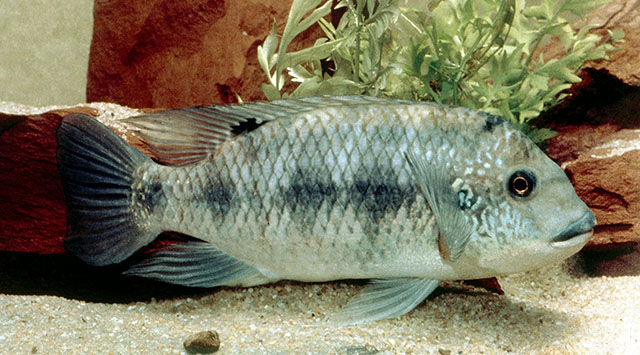| Cichlidae (Cichlids), subfamily: Pseudocrenilabrinae |
| 30 cm SL (male/unsexed) |
|
benthopelagic; freshwater; brackish; marine |
| Africa: coastal basins, fresh waters, brackish and marine waters from mouth of Senegal River (Senegal) to mouth of the Cuanza River (Angola) (Ref. 81260), sometimes ascending far up rivers. |
|
Dorsal spines (total): 14-16; Dorsal soft rays (total): 12-13; Anal spines: 3-3; Anal soft rays: 8-10. Diagnosis: upper profile of head strongly convex; lower pharyngeal bone about as long as broad, and with anterior lamella shorter than toothed area (Ref. 53405). 10 or fewer rakers on lower limb of first arch; unpaired fins not predominantly red-brown; mouth terminal; 29-30 scales on lateral line; outer row teeth robust (Ref. 81260). Dorsal fin with 14-16 spines and 12-13 soft rays (total rays 27-29) (Ref. 53405, 81260). Anal fin with 3 spines and 8-10 soft rays; caudal fin weakly covered with scales at base or entirely membranous (Ref. 81260). Caudal without spots, grey on upper lobe, yellow on lower; large vertical stripes weakly pronounced on flanks; flank scales with a blackish mark at base (Ref. 53405, 81260). No bifurcated dark vertical bars on flanks; dorsal and anal without orange-red upper margin (Ref. 53405). Length of caudal peduncle 10.5-12.9% of standard length (Ref. 81260).
Description: head length 29.7-34.1% SL (Ref. 81260). Lower pharyngeal jaw with unicuspid curved anterior teeth (Ref. 81260) and tricuspid posterior teeth (Ref. 53405, 81260). Ventral keel shorter than dentigerous plate (Ref. 81260). 3-6 rows of teeth in oral jaws (Ref. 81260), outer row teeth, bicuspid, not spatulate (Ref. 53405, 81260), inner jaw teeth tricuspid (Ref. 53405). Micro-gillrakers present; scales cycloid (Ref. 53405).
Coloration: in life: ground color silvery (Ref. 52307, 53405, 81260) to brownish (sometimes a bit
greenish)(Ref. 52307), changing to whitish on belly and to yellowish-green on back and top of head (Ref. 53405, 81260). All scales on sides with black spot at base (Ref. 52307, 53405, 81260). Sides with 6-8 rather indistinct darker cross bars (Ref. 53405, 81260), often irregularly separated into dark blotches (Ref. 52307). Additionally, 2 longitudinal stripes are visible when fish is stressed (Ref. 52307). Upper surface of snout dark green; lower lip, breast and belly white; dorsal fin greyish to transparent, with distinct "tilapia spot", and some light lines between spines and on soft part, as well as some dark and light bands or light round spots; caudal fin unspotted, its upper part greyish and lower yellowish; anal fin greyish, its distal margin darker (Ref. 53405, 81260). Pelvics greyish to blackish (Ref. 52307, 53405, 81260), white-edged anteriorly (Ref. 53405, 81260). Pectoral fins transparent or sometimes tinged with yellow at base (Ref. 53405, 81260). Throat (Ref. 81260), breast (Ref. 53405) and belly sometimes reddish or blackish after preservation (Ref. 53405). Specimens between 2-13cm SL with tendency to show bicolour caudal fin, clear yellowish dorsally and dark yellowish ventrally; specimens above 13cm SL with bicolour caudal fin without dots (Ref. 57660). |
| Very tolerant of elevated salinities, found in pure seawater, even reproduction in these highly saline environments is possible (Ref. 52307). Feeds on shrimps, bivalves, plankton (Ref. 28587), detritus (Ref. 28587, 52307), higher plants, algae, aufwuchs and small crustaceans (Ref. 52307). Oviparous (Ref. 205). Very prolific, spawning up to every 3 weeks (Ref. 52307). Pair bonding, open (Ref. 52307) substrate brooder/spawner (Ref. 52307, 81260) with both parents guarding the brood (Ref. 52307). |
|
Least Concern (LC); Date assessed: 21 April 2019 Ref. (130435)
|
| harmless |
|
Source and more info: www.fishbase.org. For personal, classroom, and other internal use only. Not for publication.

